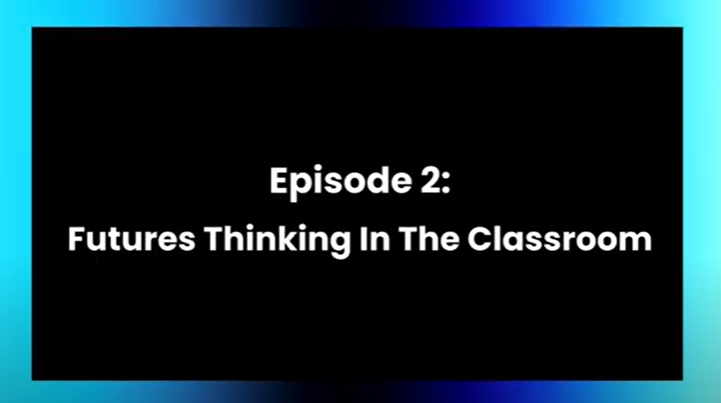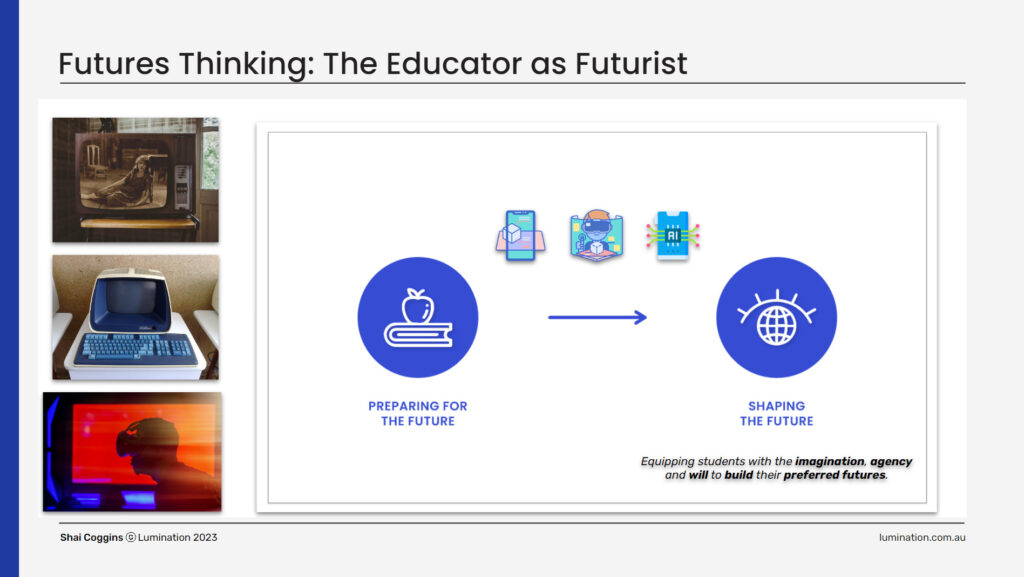Unit A: Futures Thinking

In this unit, we will cover the ‘Why’ of Immersive Learning: Futures Thinking.
Watch the video below and respond to the task, then you can mark this unit as ‘Completed’.
(Video Duration: 4 mins 37 secs)
Pre-Intro:
It feels really strange to think about it, but there was a time when we didn’t have computers or the internet in the classroom. Going further back, there was also a time when students didn’t watch videos to supplement learning, and they had to do all their math computations without a calculator. It may not seem like it, but the first teachers who introduced videos, calculators, and computers in the classroom were futurists of their time. Now, a new age of learning is unfolding with the introduction of Extended Reality technologies like VR and AR, Artificial Intelligence, and other emerging technologies. As educators, how are we equipping our students with futures thinking amidst this rapid growth and development in our society?
[Series Title Animation]
Intro:
Welcome to ImmersEDU! I’m Shai Coggins, an immersive learning specialist, and Learning Design Lead at Lumination.
In this episode, we’re talking about futures thinking, which is one of the learning frameworks that we use at Lumination.
From an education perspective, futures thinking is a cross-disciplinary approach that enables learners to consider potential futures through the exploration of trends and drivers for change. This includes being able to evaluate different types of future scenarios: the possible, the probable, and the preferable futures.
Notice I didn’t say predicting futures. That’s because futures thinking is not about making predictions. It is about developing critical thinking skills that enable learners to consider the future carefully, helping them to make better and more informed decisions and to take decisive actions in the present.
Expound:
So, how can we teach futures thinking to our students?
In the Australian Curriculum, creating solutions for preferred futures is the overarching core concept of the Technologies learning area. This core concept involves identifying compelling visions of the future and making considered design decisions that take different factors into account.
But Technologies isn’t the only area we should encourage the use of futures thinking. In reality, most subject areas would benefit from this approach. In industry, this skill has been vital in the development of different sectors other than technology. It plays a huge part in policies for environment, finance, energy, and transport.
There are many ways we can start including futures thinking skills in our teaching. We can use relevant prompts or thinking routines to encourage discussions, research projects, presentations, and journals.
Let’s say, you’re looking at studying transportation. You can guide your students in reviewing the existing situation in this sector. What are the good and exciting things that are happening now? What are the issues and challenges?
Next, you can look at the trends. What is the current situation like compared to the past? Are there recurring patterns?
Then, analyse the drivers of change. Are the differences between past and present influenced by technology, economy, environment, or other factors?
From here, you can then look at possible, probable, and preferable future scenarios. Ask the students: What might happen? What is likely to happen? What would you like to happen?
Students can then design potential solutions and ideas based on these guiding questions.
We study history to learn, analyze, and interpret human identities and transformations of societies and civilizations over time. Learning about the past helps us to understand the present and prepare for the future.
Futures thinking is a skill that helps learners not only to prepare for the future but also to enable them to shape the future.
Outro:
Here at Lumination, we aim to equip and empower educators to become today’s futurists in the classroom. If you want to know how you can incorporate futures thinking using immersive learning in your teaching practice, contact our team to find out more.
Now, if you found this video helpful, please don’t forget to like and subscribe. Make sure you get notified when we share new episodes from our education series. See you again next time on ImmerseEDU!

At Lumination, we believe that educators who introduce immersive learning in the classroom are futurists. Much like the first teachers who first introduced videos, computers, or calculators in teaching.
Using technologies like AR and VR helps teachers to look at not just preparing students for the future – but actually helping students to shape the future.

